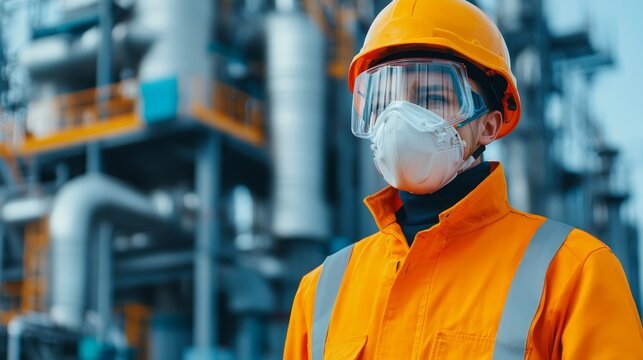Welding is an essential process in various industries, including construction, automotive manufacturing, shipbuilding, and aerospace. However, it also poses significant health risks to workers due to exposure to hazardous substances and environmental conditions. Understanding these risks and implementing appropriate respiratory protection measures are critical to safeguarding the health of welders.

Health Risks Associated with Welding
Welding involves heating metals to high temperatures, which produces fumes, gases, and particulates that can be harmful when inhaled. These contaminants vary depending on the type of welding process, base metal, filler material, and coatings used. Some of the most common health risks associated with welding include:
- Respiratory Issues: Welding fumes contain fine particles of metal oxides and other compounds, such as chromium, nickel, manganese, and zinc. When inhaled, these particles can cause irritation of the nose, throat, and lungs. Prolonged exposure may lead to chronic bronchitis, asthma, or even lung cancer.
- Metal Fume Fever: This flu-like illness occurs after short-term exposure to certain welding fumes, particularly those containing zinc oxide. Symptoms include fever, chills, nausea, muscle aches, and fatigue. While usually temporary, repeated episodes can have cumulative effects on health.
- Neurological Damage: Manganese, a common component in welding fumes, has been linked to neurological disorders similar to Parkinson’s disease. Long-term exposure can result in impaired motor skills, tremors, and cognitive decline.
- Carcinogenic Effects: Certain welding processes generate carcinogens like hexavalent chromium and nickel compounds. Chronic exposure increases the risk of developing cancers of the lung, nasal cavity, and larynx.
- Skin and Eye Irritation: Ultraviolet (UV) radiation emitted during welding can damage skin and eyes if not properly protected. Additionally, contact with chemicals used in welding operations may cause dermatitis or allergic reactions.
Importance of Respiratory Protection
Given the potential severity of these health risks, adequate respiratory protection is crucial for all welders. Effective protective measures reduce the likelihood of inhaling dangerous fumes and particulates, thereby minimizing long-term health consequences. Below are key strategies for ensuring proper respiratory protection:
- Engineering Controls: Implementing engineering controls, such as local exhaust ventilation systems, reduces airborne contaminant levels at the source. These systems capture fumes before they disperse into the surrounding air, creating a safer working environment.
- Personal Protective Equipment (PPE): Welders must wear appropriate PPE, including respirators designed to filter out specific types of particles and gases. There are several classes of respirators available:
- Disposable Masks: Suitable for low-contaminant environments but insufficient for heavy welding tasks.
- Disposable Respirators: Provide better filtration and are effective against most welding fumes.
- Full-Face Respirators: Offer enhanced protection by covering both the nose and mouth, as well as shielding the eyes from UV rays.
- Powered Air Purifying Respirators (PAPRs): Ideal for high-exposure scenarios, these devices supply clean air through a battery-powered fan, ensuring optimal breathing comfort.
- Proper Fit Testing: Ensuring that respirators fit correctly is vital for their effectiveness. Ill-fitting masks allow contaminated air to leak in, negating the purpose of the equipment. Regular fit testing should be conducted according to occupational safety standards.
- Training and Education: Employers must educate workers about the hazards of welding and how to use respiratory protection effectively. Training programs should emphasize the importance of maintaining PPE, recognizing symptoms of overexposure, and reporting unsafe conditions promptly.
- Regular Maintenance: Respirators require routine inspection and maintenance to remain functional. Filters should be replaced as needed, and any damaged components must be repaired or discarded immediately.

Additional Safety Measures
In addition to respiratory protection, other precautions can further enhance welder safety:
- Workplace Design: Arrange workstations to minimize cross-contamination between areas where welding occurs and other parts of the facility.
- Administrative Controls: Limit the duration of exposure to welding fumes by rotating shifts or scheduling breaks.
- Monitoring Air Quality: Conduct regular air sampling to measure contaminant levels and adjust control measures accordingly.
- Promoting Hydration: Encourage welders to stay hydrated, as this helps flush toxins from the body more efficiently.
Welding plays a pivotal role in modern industry, yet its associated health risks cannot be ignored. Exposure to welding fumes and gases can lead to serious respiratory issues, neurological damage, and increased cancer risks. By prioritizing respiratory protection through engineering controls, personal protective equipment, training, and maintenance, employers can significantly mitigate these dangers. A proactive approach to safety ensures that welders remain healthy and productive while contributing to society’s infrastructure and technological advancements. Ultimately, protecting the well-being of welders benefits everyone involved—workers, companies, and communities alike.


